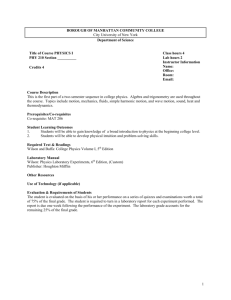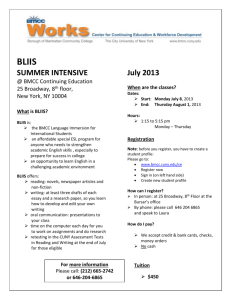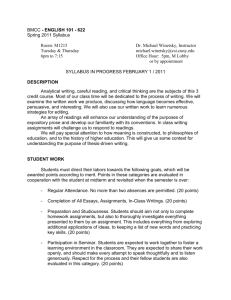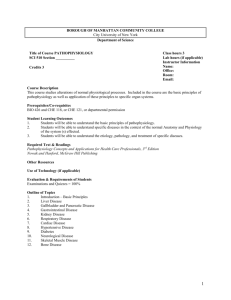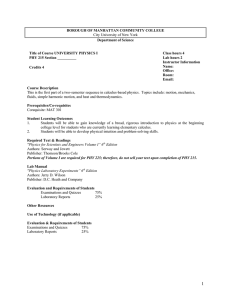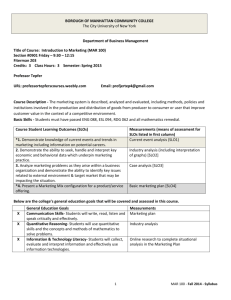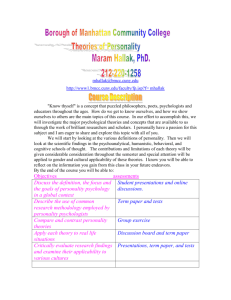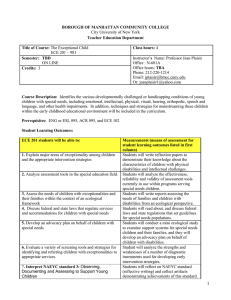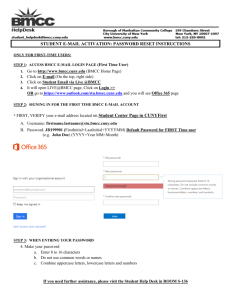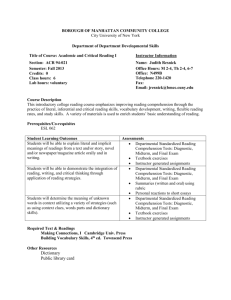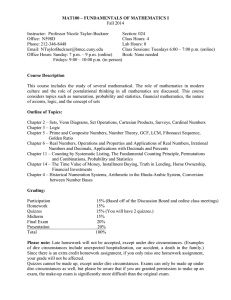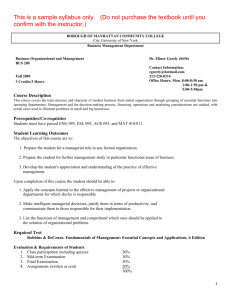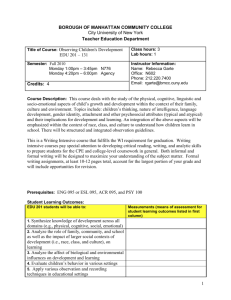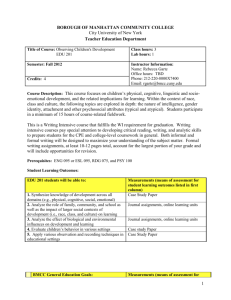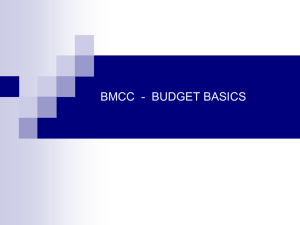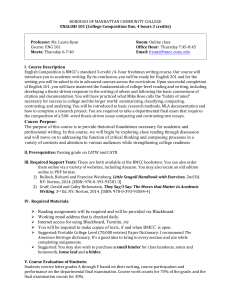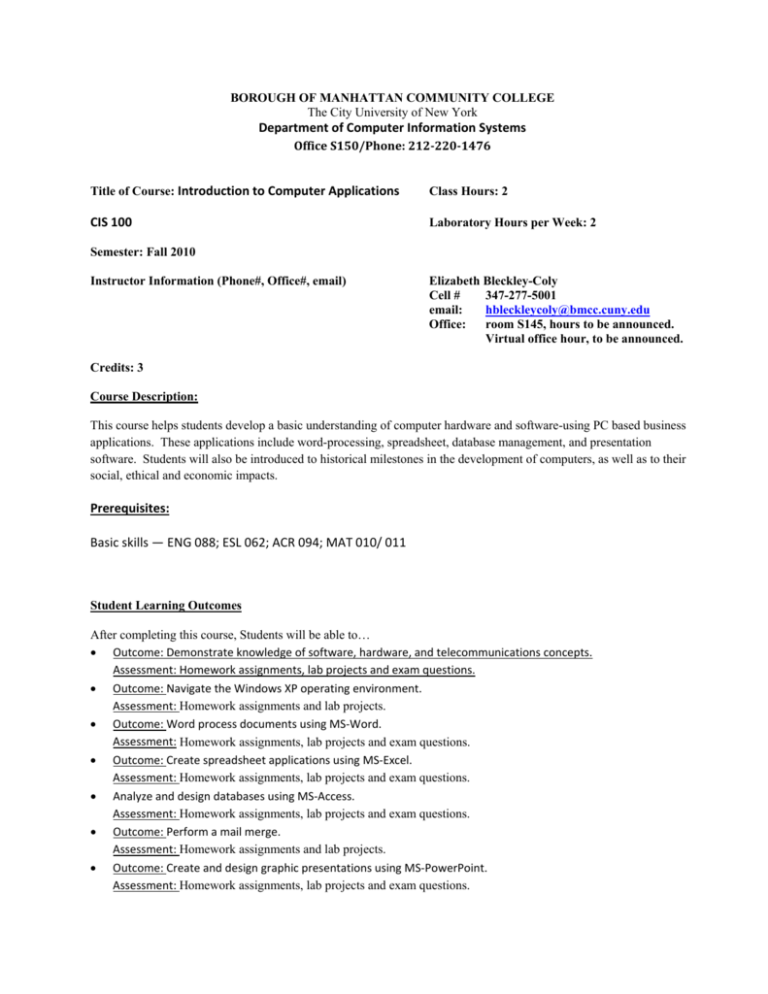
BOROUGH OF MANHATTAN COMMUNITY COLLEGE
The City University of New York
Department of Computer Information Systems Office S150/Phone: 212­220­1476 Title of Course: Introduction to Computer Applications
Class Hours: 2
CIS 100 Laboratory Hours per Week: 2
Semester: Fall 2010
Instructor Information (Phone#, Office#, email)
Elizabeth Bleckley-Coly
Cell #
347-277-5001
email:
hbleckleycoly@bmcc.cuny.edu
Office:
room S145, hours to be announced.
Virtual office hour, to be announced.
Credits: 3
Course Description:
This course helps students develop a basic understanding of computer hardware and software-using PC based business
applications. These applications include word-processing, spreadsheet, database management, and presentation
software. Students will also be introduced to historical milestones in the development of computers, as well as to their
social, ethical and economic impacts.
Prerequisites: Basic skills — ENG 088; ESL 062; ACR 094; MAT 010/ 011 Student Learning Outcomes
After completing this course, Students will be able to…
• Outcome: Demonstrate knowledge of software, hardware, and telecommunications concepts. Assessment: Homework assignments, lab projects and exam questions. • Outcome: Navigate the Windows XP operating environment. Assessment: Homework assignments and lab projects.
• Outcome: Word process documents using MS‐Word. Assessment: Homework assignments, lab projects and exam questions.
• Outcome: Create spreadsheet applications using MS‐Excel. Assessment: Homework assignments, lab projects and exam questions.
• Analyze and design databases using MS‐Access. Assessment: Homework assignments, lab projects and exam questions.
• Outcome: Perform a mail merge. Assessment: Homework assignments and lab projects.
• Outcome: Create and design graphic presentations using MS‐PowerPoint. Assessment: Homework assignments, lab projects and exam questions.
CIS 100 — Introduction to Computer Applications General Education Learning Outcomes And Assessments
Quantitative Reasoning — Students will be able to use quantitative skills and the concepts and methods of
mathematics to solve problems
Assessment:
•
•
Use formulas and concepts of mathematics to solve problems in designing, analyzing and implementing
spreadsheets in Microsoft Excel.
Use formulas and concepts of mathematics to solve problems in designing, analyzing and implementing
databases in Microsoft Access.
Information & Technology Literacy — Students will be able to collect, evaluate and interpret information and
effectively use information technologies.
Assessment:
•
•
•
•
Use Microsoft Word to create documents and mailing labels.
Use Microsoft Excel to create spreadsheets and charts.
Use Microsoft Access to create tables, queries, forms and reports.
Use Microsoft PowerPoint to create presentations.
Required Text:
Textbook: Author: Publisher: ISBN 10 ISBN 13: GO! With Microsoft Office, Introductory and MyITLAB Access Code Shelley Gaskin, Robert Ferrett, Alicia Vargas, and Suzanne Marks Pearson/ Prentice Hall 0558349943 978‐0‐5‐5834994‐3 Other Resources: Flash drive (recommended).
Evaluation and Requirements of Students
Homework My IT Lab projects Word Exam Excel Exam Access Exam PowerPoint Exam 10% 10% 20% 20% 20% 20% 100% 2 CIS 100 — Introduction to Computer Applications College Attendance Policy
At BMCC, the maximum number of absence hours is limited to one more class hour than the contact hours as indicated
in the BMCC college catalog. For example, you may be enrolled in a four-hour class that meets four times a week.
You are allowed five hours of absence, not five days. In the case of excessive absence, the instructor has the option to
lower the grade or assign an “F” or “WU” grade. Academic Adjustments for Students with Disabilities
Students with disabilities who require reasonable accommodations or academic adjustments for this course must contact
the Office of Services for Students with Disabilities. BMCC is committed to providing equal access to all programs and
curricula to all students.
BMCC Policy on Plagiarism and Academic Integrity Statement
Plagiarism is the presentation of someone else’s ideas, words or artistic, scientific, or technical work as one’s own
creation. Using the idea or work of another is permissible only when the original author is identified. Paraphrasing and
summarizing, as well as direct quotations, require citations to the original source. Plagiarism may be intentional or
unintentional. Lack of dishonest intent does not necessarily absolve a student of responsibility for plagiarism. Students
who are unsure how and when to provide documentation are advised to consult with their instructors. The library has
guides designed to help students to appropriately identify a cited work. The full policy can be found on BMCC’s
website, www.bmcc.cuny.edu. For further information on integrity and behavior, please consult the college bulletin
(also available online).
3

